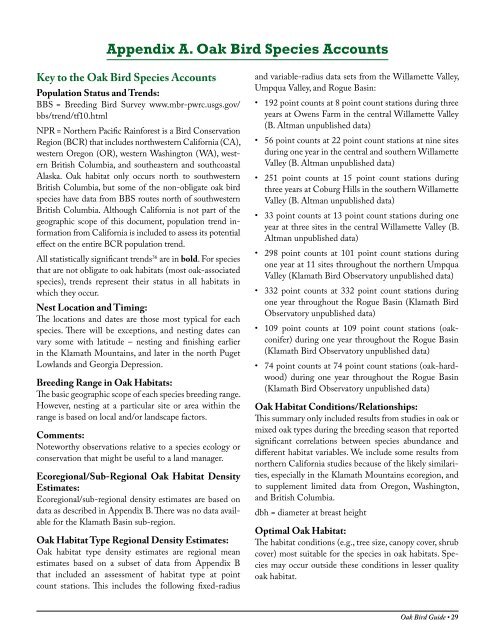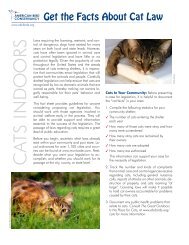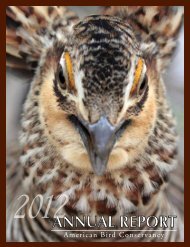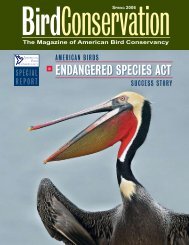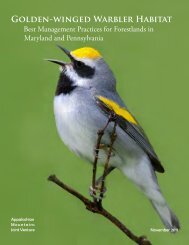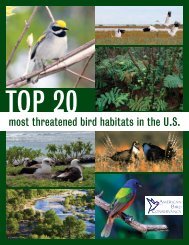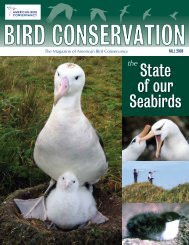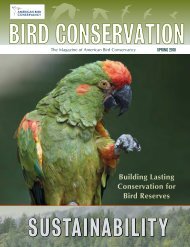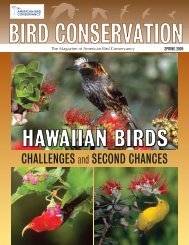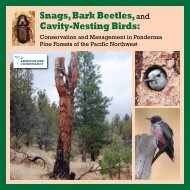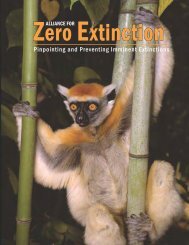Oak Ecosystems in the Pacific Northwest - American Bird Conservancy
Oak Ecosystems in the Pacific Northwest - American Bird Conservancy
Oak Ecosystems in the Pacific Northwest - American Bird Conservancy
Create successful ePaper yourself
Turn your PDF publications into a flip-book with our unique Google optimized e-Paper software.
Appendix A. <strong>Oak</strong> <strong>Bird</strong> Species Accounts<br />
Key to <strong>the</strong> <strong>Oak</strong> <strong>Bird</strong> Species Accounts<br />
Population Status and Trends:<br />
BBS = Breed<strong>in</strong>g <strong>Bird</strong> Survey www.mbr-pwrc.usgs.gov/<br />
bbs/trend/tf10.html<br />
NPR = Nor<strong>the</strong>rn <strong>Pacific</strong> Ra<strong>in</strong>forest is a <strong>Bird</strong> Conservation<br />
Region (BCR) that <strong>in</strong>cludes northwestern California (CA),<br />
western Oregon (OR), western Wash<strong>in</strong>gton (WA), western<br />
British Columbia, and sou<strong>the</strong>astern and southcoastal<br />
Alaska. <strong>Oak</strong> habitat only occurs north to southwestern<br />
British Columbia, but some of <strong>the</strong> non-obligate oak bird<br />
species have data from BBS routes north of southwestern<br />
British Columbia. Although California is not part of <strong>the</strong><br />
geographic scope of this document, population trend <strong>in</strong>formation<br />
from California is <strong>in</strong>cluded to assess its potential<br />
effect on <strong>the</strong> entire BCR population trend.<br />
All statistically significant trends 36 are <strong>in</strong> bold. For species<br />
that are not obligate to oak habitats (most oak-associated<br />
species), trends represent <strong>the</strong>ir status <strong>in</strong> all habitats <strong>in</strong><br />
which <strong>the</strong>y occur.<br />
Nest Location and Tim<strong>in</strong>g:<br />
The locations and dates are those most typical for each<br />
species. There will be exceptions, and nest<strong>in</strong>g dates can<br />
vary some with latitude – nest<strong>in</strong>g and f<strong>in</strong>ish<strong>in</strong>g earlier<br />
<strong>in</strong> <strong>the</strong> Klamath Mounta<strong>in</strong>s, and later <strong>in</strong> <strong>the</strong> north Puget<br />
Lowlands and Georgia Depression.<br />
Breed<strong>in</strong>g Range <strong>in</strong> <strong>Oak</strong> Habitats:<br />
The basic geographic scope of each species breed<strong>in</strong>g range.<br />
However, nest<strong>in</strong>g at a particular site or area with<strong>in</strong> <strong>the</strong><br />
range is based on local and/or landscape factors.<br />
Comments:<br />
Noteworthy observations relative to a species ecology or<br />
conservation that might be useful to a land manager.<br />
Ecoregional/Sub-Regional <strong>Oak</strong> Habitat Density<br />
Estimates:<br />
Ecoregional/sub-regional density estimates are based on<br />
data as described <strong>in</strong> Appendix B. There was no data available<br />
for <strong>the</strong> Klamath Bas<strong>in</strong> sub-region.<br />
<strong>Oak</strong> Habitat Type Regional Density Estimates:<br />
<strong>Oak</strong> habitat type density estimates are regional mean<br />
estimates based on a subset of data from Appendix B<br />
that <strong>in</strong>cluded an assessment of habitat type at po<strong>in</strong>t<br />
count stations. This <strong>in</strong>cludes <strong>the</strong> follow<strong>in</strong>g fixed-radius<br />
and variable-radius data sets from <strong>the</strong> Willamette Valley,<br />
Umpqua Valley, and Rogue Bas<strong>in</strong>:<br />
• 192 po<strong>in</strong>t counts at 8 po<strong>in</strong>t count stations dur<strong>in</strong>g three<br />
years at Owens Farm <strong>in</strong> <strong>the</strong> central Willamette Valley<br />
(B. Altman unpublished data)<br />
• 56 po<strong>in</strong>t counts at 22 po<strong>in</strong>t count stations at n<strong>in</strong>e sites<br />
dur<strong>in</strong>g one year <strong>in</strong> <strong>the</strong> central and sou<strong>the</strong>rn Willamette<br />
Valley (B. Altman unpublished data)<br />
• 251 po<strong>in</strong>t counts at 15 po<strong>in</strong>t count stations dur<strong>in</strong>g<br />
three years at Coburg Hills <strong>in</strong> <strong>the</strong> sou<strong>the</strong>rn Willamette<br />
Valley (B. Altman unpublished data)<br />
• 33 po<strong>in</strong>t counts at 13 po<strong>in</strong>t count stations dur<strong>in</strong>g one<br />
year at three sites <strong>in</strong> <strong>the</strong> central Willamette Valley (B.<br />
Altman unpublished data)<br />
• 298 po<strong>in</strong>t counts at 101 po<strong>in</strong>t count stations dur<strong>in</strong>g<br />
one year at 11 sites throughout <strong>the</strong> nor<strong>the</strong>rn Umpqua<br />
Valley (Klamath <strong>Bird</strong> Observatory unpublished data)<br />
• 332 po<strong>in</strong>t counts at 332 po<strong>in</strong>t count stations dur<strong>in</strong>g<br />
one year throughout <strong>the</strong> Rogue Bas<strong>in</strong> (Klamath <strong>Bird</strong><br />
Observatory unpublished data)<br />
• 109 po<strong>in</strong>t counts at 109 po<strong>in</strong>t count stations (oakconifer)<br />
dur<strong>in</strong>g one year throughout <strong>the</strong> Rogue Bas<strong>in</strong><br />
(Klamath <strong>Bird</strong> Observatory unpublished data)<br />
• 74 po<strong>in</strong>t counts at 74 po<strong>in</strong>t count stations (oak-hardwood)<br />
dur<strong>in</strong>g one year throughout <strong>the</strong> Rogue Bas<strong>in</strong><br />
(Klamath <strong>Bird</strong> Observatory unpublished data)<br />
<strong>Oak</strong> Habitat Conditions/Relationships:<br />
This summary only <strong>in</strong>cluded results from studies <strong>in</strong> oak or<br />
mixed oak types dur<strong>in</strong>g <strong>the</strong> breed<strong>in</strong>g season that reported<br />
significant correlations between species abundance and<br />
different habitat variables. We <strong>in</strong>clude some results from<br />
nor<strong>the</strong>rn California studies because of <strong>the</strong> likely similarities,<br />
especially <strong>in</strong> <strong>the</strong> Klamath Mounta<strong>in</strong>s ecoregion, and<br />
to supplement limited data from Oregon, Wash<strong>in</strong>gton,<br />
and British Columbia.<br />
dbh = diameter at breast height<br />
Optimal <strong>Oak</strong> Habitat:<br />
The habitat conditions (e.g., tree size, canopy cover, shrub<br />
cover) most suitable for <strong>the</strong> species <strong>in</strong> oak habitats. Species<br />
may occur outside <strong>the</strong>se conditions <strong>in</strong> lesser quality<br />
oak habitat.<br />
<strong>Oak</strong> <strong>Bird</strong> Guide • 29


